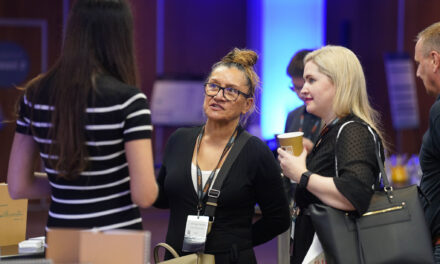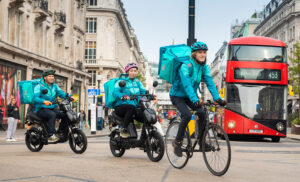Welcome to Let’s Talk Fleet Risk, a podcast for those who manage drivers and vehicles, and want to reduce road risk in their organisation. In this episode, I’m talking to Kate Walker, Managing Director of the Diabetes Safety Organisation.
We’ll be discussing:
- Why Driver Safety Managers need to understand the hidden epidemic that is diabetes.
- When is diabetes a DVLA notifiable condition?
- The potential consequences of a typical on-the-road diet, enabling conversations with employees around driving with diabetes.
- Good practice for managing diabetes risk, and some resources to help.
You can listen to the podcast by clicking below
You can also read the transcript from the session below
Simon: Hello everyone and welcome to this edition of Let’s Talk Fleet Risk. This quarter we’re looking at various aspects of fitness to drive, and my guest today is Kate Walker, who is Managing Director of the Diabetes Safety Organisation.
Advertisement
Welcome to the podcast Kate.
Kate: Thanks for having me today, Simon.
Simon: Kate your website says that diabetes is a hidden epidemic leaving all companies exposed to increased absenteeism, increased risk of accidents, and therefore increased risk of company liability, so, why is that? And why does somebody who manages the safety of people who drive for work need to listen to this podcast?
Kate: I think it’s really important to address this epidemic of diabetes. I think it’s hidden in several ways, so I don’t think people necessarily living with it understand the complexity of it. And also, I think it’s hidden in the workplace.
There’s actually one in 12 in the working population living with diabetes and we’ve just hit 5 million people in the UK. And we can touch on some of the stats in a minute but in terms of your question around why, why is this important for a manager… I think we need to understand that diabetes is a known foreseeable risk in the workplace. And there is legislation that needs to be followed, which again, is often not understood – people think diabetes and they think medical, GPs. And I think there’s a lot of work that needs to be done around bringing this to light and removing the stigma, and also understanding the implications in the workplace.
We know that there are 5 million people with the condition. A further 12.6 million in the UK have pre-diabetes. So, these numbers are significant. And if people are unmanaged, time off of work increases, there is an increased risk of accidents from those who are undiagnosed, or those who are not necessarily managing it as well – we know it’s not always easy to get GP appointments, or the time and support that may be needed for people living with diabetes. And there’s also the experience we have when we’re going to companies – it’s hard for people to come forward and share, because of the unknown. Are they going to lose their job? Is their job still safe? What are the requirements? You know, it’s either let’s not get diagnosed and we never have to address it, or let’s hide away from it – and that poses a risk in so many different ways. As an employer as well – and I think for any safety managers –there’s a real need to understand the difference between the two types of diabetes, which we’ll come on to.
The right conversation needs to be had, also to understand that the Health and Safety at Work Act does come in here, and people, need to make sure they are managing this risk. People living with diabetes have to also comply with DVLA regulations, and they fit under the Equality Act because, more often than not, diabetes would be a disability. So, for all of those reasons, I think we really need to start a conversation around diabetes across the industry to make our roads safer and to help anyone who is living with it to feel safe to come forward, and really be able to share and understand that it’s okay and safe to do so.
Simon: Before we started this discussion, I went on the DVLA’s website just to see what they had to say about diabetes and notifiable conditions. And it said that if you have diabetes and you manage it with diet, it’s not notifiable. But if you do need insulin, it is notifiable.
Advertisement
So am I right in thinking that if you’re treating with insulin, it’s type one, if you’re treating with diet, it’s type two. And if so, what’s the difference? And I guess, how do you come to have diabetes?
Kate: So no, it’s not only type one on insulin. And again, this question alone, I think really raises a good question of how can we have the right conversation in the workplace if we don’t understand diabetes and the two variations here?
So, type one people living with diabetes often are frustrated. So, type one diabetes is an autoimmune disease – at some point, their body had a reaction and now their pancreas, which produces insulin, no longer works. And of the 5 million, only 4% – about 400,000 – are living with type one diabetes. Predominantly everybody else is living with type two. In my experience, when we work with people with type one diabetes, they find it frustrating that they are bundled into the same category, and they’re not understood. You’ll often see them now with sensors on their arms, and they have to manage their diabetes throughout the day – so any time they eat, they have to put the right insulin in. They’re effectively self-regulating their own blood sugar levels, which we – myself, as someone not living with diabetes – take for granted; my blood sugars are managed for me. They’re having to deal with it – it’s effectively like another job. Even temperature can cause insulin to do something. As a condition, it’s a lot of work for someone living with it.
On the other side, we’ve got people living with type 2 – so that’s 95 % of the 5 million – and 600 ,000 people with type 2 diabetes are also on insulin. Now, the condition is different. So, for type 2 diabetes, it’s often progressive. The easiest analogy – if we use vehicles – is if I was driving down to London from Birmingham in first gear, we wouldn’t be surprised if my car engine was smoking. I hadn’t changed gears. If I turn around, come back, change gears, hopefully I’m in no further trouble. If I keep driving at first, at some point the engine will smoke and it will breakdown.
The pancreas, from the perspective of living with type two diabetes is very similar. So, if we look after our body, it will work effectively. Over time, if we keep driving in first or pushing too much in – and that could be stress, it could be other medical conditions, it could be the choices of foods, lifestyle… there’s many factors that contribute to type two. But if it all pushes on that organ too often, at some point we get the smoke, the warning signs of diabetes, pre-diabetes. And if we ignore that, it turns into type two diabetes.
Sadly, it’s a progressive disease – caught early it can be managed on food and lifestyle choices. But left, or not well-managed, it can need medication from different strengths of tablets – some of them strong, and reportable to the DVLA – right up to insulin. So, people living with type two diabetes who are on insulin, they don’t become type one – they are type two on insulin. As I said, there are 600,000 in the UK.
So, when we look at insulin, often people with type one diabetes have had it since they were young, and they get a lot of support. Often people with type two diabetes on insulin are not as well educated because there’s not as much support for them. So, I think it’s another place, in the workplace, to help educate and support people living with both types of diabetes on insulin. And under DVLA regulations, they have to test every 2 hours whilst driving on insulin to ensure the blood levels are correct – safely – for the prevention of any accidents happening due to their blood sugar levels dropping too quickly and having a hype.
So, if we can have managers and people inside companies understanding the difference, understanding the requirements of people, and the differences that they’re living with, it really allows it to become safer – and there are no blanket bans in the UK. So again, anyone can drive as long as their blood sugars are well managed and they’re looking after themselves.
Advertisement
Simon: Well, what would be typical symptoms of someone who is pre-diabetic?
Kate: Classic symptoms of pre-diabetes is over-thirsty. Changing sexual excitement. Going to the toilet regularly. Getting too hot. The difficulty – which is why we say that it’s hidden – is they’re very subtle symptoms. Over-fatigued, can feel more stressed than normal… they’re all symptoms we could put down to a busy day, or work, or drinking too much. Diabetes UK have a Know Your Risk Score – you can do some questions and check it out and I absolutely recommend it. The sooner we catch the pre-diabetes, or the edge of diabetes, it’s reversable for many – not all – and actually, it prevents the complications and the damage that occurs, which are really the major problems that come with diabetes down the line. So, there are some good solutions to it but caught early it can make a massive difference.
Simon: You said previously that diet was one of the possible contributory factors, and a lot of the drivers that are managed by the audience on the call today… a lot of those drivers are on the road all day and they rely on cafes petrol stations, motorway service stations, etcetera for their daily nutrition, which obviously isn’t great. What are the likely consequences of that?
Kate: Yeah, I think this is an industry that is faced with some additional challenges. We’ve got to look at what impacts diabetes. Stress does, as we’ve said, nutrition does, movement does. So, can we move a little bit more? Well, that’s let’s have a little walk around whilst we’re in those cafes and petrol stations just a little bit longer.
The food choices are interesting. We all know what it’s like to stop at a cafe, but are there better choices? I think we live in a really interesting time where we’re seeing huge amounts of sugar in things, or chemical sugars, and processed foods. My question always is, could they take something? Maybe, maybe not. If we do go to a café or petrol station, what is the better option? Not the best, necessarily, but what would be better? Is there a cottage pie and vegetables, over a burger and chips – because there’s less starch, more nourishment. That would make a difference. I think we’ve forgotten that a small amount over time will make a difference. And I think it’s about going in and making a better, informed choice – instead of the big grab bags, can we just have a normal bag of crisps. If that’s 5 days a week, by the end of the year, it’s a significantly smaller amount of food eaten. That could be the catalyst to be enough not to go into diabetes.
Simon: Absolutely, it’s so easy to go for those bigger portions because they’re very good at marketing it, aren’t they?
————–
The Driving for Better Business Van Driver Toolkit contains guidance on combating a range of other fit-to-drive challenges, including fatigue and driver impairment. There’s a range of fact sheets and pre-recorded toolbox talks that are all free to access. The web address is in the show notes.
Advertisement
————–
Simon: Your website says that 1 million people don’t know they have the condition. So, how do you start a discussion around diabetes? Because I imagine there’s some stigma felt by people who have diabetes about discussing it. And how do we create a culture where that stigma is minimized, and it allows that discussion to take place?
Kate: Yeah absolutely, and it’s a big part of the work we do. I think it’s frightening to think there’s 1 million people that are undiagnosed, and for me, before we kind of get on how do we do this, and stigma, why it concerns me is that the longer we leave diabetes unmanaged our blood sugars get higher. So, if we imagined a glass of sugary water and dropped a dull coin in over time it would shine the coin. Sadly, as we are not robots, internally, what actually happens is it starts to rot us inside. So that’s why we get damage to the nerves in the feet – people can end up with lack of sensation in their feet which, in this industry, is a scary concept.
It damages eyes – diabetes is the leading cause of blindness in the working population. And also, nerves, particularly for men around your manhood and erectile disfunction. 75% of men who have diabetes get erectile disfunction at some point.
So, when we understand the risks, it starts to beg the question – how do we help people to think it’s safe to go and get tested. And this industry is very challenging because we have to recognise as a driver – if they’re the key breadwinner at home and they are nervous they may lose a job, that’s quite a frightening concept. It’s easier to bury their head and ignore it, and we know that’s often done.
So how do we start this, as you say, this conversation? And I do think there’s a part where employers can start to say, look, here’s a sign of symptoms, how do we start sharing this with you – we’re not trying to remove from the company. Actually, we’re trying to help you stay well and safer and keep you in employment for longer.
Because the complications from diabetes are what cause people to have to quit their jobs – we have 190 amputations a week in the UK from diabetes from the toe upwards. So, if we can capture this early, we can give good quality information and make people realise it is safe to come forward and share, there is no stigma… and it’s not always because of what you’ve eaten, it’s not always poor choices. There could be 1001 reasons why your body is not able to produce, or do enough work with, insulin. If we can get this message across well, and that small changes will make a difference and you don’t have to stop everything – we could at least have a sensible conversation, like the one that we’ve seen with mental health, people do want to come forward, people do want to share, but we need to provide that space for that conversation to take place where it’s not a blame and it’s not I’m not good enough, it’s actually hey, we all don’t pick the best foods. My daughter loves Haribo’s, it’s my weak spot, they’re often in the house, you know, one for her, two for me when I make packed lunches. None of us are innocent in this, we all know this world, so how do we start to provide that opening and say let’s talk together and how do we start to make a small change, so people feel safe to come forward.
Simon: If we manage to have that discussion and a member of staff feels able to come forward and admit that they’re diabetic, how would you expect an employer to deal with that member of staff? What would be good practice for managing that diabetes risk?
Advertisement
Kate: Yeah, great question. I think firstly, from a management perspective, it’s great if they had the education around the different types of diabetes – and have a general understanding themselves, so that conversation can be well-managed and the person living with diabetes can feel heard and supported, and they’re not having to do all the education for the manager.
When we work with people living with diabetes, we hear all the time, oh, I have to tell them everything, they didn’t know anything. So, the starting place for a manager is that there is some understanding of diabetes – both type one and type two, so they can provide a safe place and an effective place. Then, it’s about asking the individual what they need – because everyone’s diabetes is different, even within type one and type two, there’s differences within that, what medicines they use, are they on medicines, what do they need… so a real open conversation to find out what that individual needs is a great starting point.
And then, if they need to take time to take blood tests, if they need somewhere to keep their insulin cool, particularly in the summer, these are all important things. Have they got somewhere on-site or with them that they’ve got their sugar and glucose shots, in case they have a hypo. Do other people need to know around them, are they happy for that to happen. These small things will make a significant difference. Do first aiders around know how to deal with diabetes and hypos? I think with all stuff, is the right risk assessment policy in place to ensure everyone understands this in the workplace to make it safe.
They’re quite small adjustments, paperwork and the background, and then small adjustments – and also ensuring they can get to medical appointments to keep them healthy and well and to keep them in work.
Simon: Can you just explain a little bit about what a hypo is, what that looks like?
Kate: Absolutely. So, a hypo is when blood sugar levels go too low. So, for us all our blood sugars vary up and down throughout the day as we need to do things. When somebody is living with diabetes, it is more often than not the medicine – specifically insulin and one of the others that is quite strong – that pull blood sugars back down to keep everything nice and safe, and keep our bloods in the nice range.
If the right food hasn’t gone in, or there’s a different stress – a lot of other factors could contribute – but something happens and the blood sugar goes below 4, generally, people will present with what is known as low blood sugar – a hypo, or hypo-glycaemic episode. And they can present very differently. Somebody might act as if drunk, they might pass out, they can go quiet and slump in a corner, they might start being unclear with their speaking, over-sweating. And their bloods are going dangerously low. And at that point, they need to be given sugar. Not in the form of chocolate as it has too much fat, but like a glucose shot, a liquid shot, to get their sugars back up and to stabilise them there.
That’s why we believe it’s really important that people around do understand if somebody has diabetes – if they’re willing to have that information shared – so they can be supported and helped. And if left untreated, it can be very serious and even go into a coma, and worse potentially.
Advertisement
Simon: Are there any common failings, around how employers manage diabetes, and how would that affect them from a duty of care perspective to those employees?
Kate: I think the largest thing that we see as we go into companies and work with organisations is we see very little understanding of diabetes. So, almost the first failing is that it’s not recognised to have any impact in the workplace. It is seen as just purely medical, it’s s medical condition. Organisations often have, if they’re big, occupational health. If someone has chosen to come forward, then they may well be under occupational health and have what we’ve talked about already in place.
The challenge is that we know 1 in 12 in the workforce have diabetes, and we know most organisations haven’t got that sort of number on their books. So, the biggest failing is understanding that they’re in the workplace and providing a culture or environment where they are free to come forward and share that safely. I think it’s the biggest failing. If we’re unfortunate enough for an event to happen where something serious or fatal happens, someone having a diabetic hypo, post-event, they will be asked what have you done that is reasonable and practicable to ensure that everything was safe? And if they said it was due to diabetes, what have you got in place? Very few organisations currently would be able to say we provide this education, the opportunity for them to come forward, we give this space. Many would say, well, they didn’t tell us.
There’s a grey area in this part, because under the Equality Act, diabetes is more often than not a disability. There is definitely a grey area, but it would be still questioned – what had you done to give them the opportunity to come forward and speak about this? So, I think one of the biggest failings is just a lack of recognizing that diabetes is a known and foreseeable risk, and putting in place awareness and education in the workplace so people can come forward. And then just ensuring that they’ve got the policies and risk assessments that would then follow on from that.
Simon: The obvious question after that is what resources are available that can help employers understand the issue? And are there any things that they can share with their drivers as well?
Kate: Absolutely. I mean, there’s some great resources out there. Diabetes UK have a risk assessment and lots of information. We have a charity arm called Cuppa Squad – it’s free to access for anyone living with diabetes to join support groups because it’s not always easy to live with diabetes.
From an employer’s point of view, there is less available. From ourselves, we provide a lot of work around awareness and education. And then it’s simple stuff, like campaigns that can be done to bring awareness about symptoms, about health choices… there are resources available. There aren’t as many directed purely at the workplace, around the legal side, but we can help with that. And I know the work you do around policies and risk assessments will all come together and work as a collective for an employer.
And one of the things we spoke about earlier was the One Less campaign, which we provide for free for any organisation, around if you had just one less spoonful of sugar in a coffee, or tea, or hot chocolate – one less, six cups a day, it’s a whole kilogram bag less of sugar a month, and by the end of the year that’s 12 bags of sugar. If you’re pre-diabetic and took out 12kg of sugar, that could be the saving grace. And suddenly, over a couple of weeks, you get used to not having it. So, we have a whole campaign that can be put into place, and these small changes will really make a difference – so it’s free if anyone does want these resources.
Advertisement
And it’s about opening up those conversations in companies, bringing it to light and then providing simple steps for those who choose to take them.
Simon: I think that’s fantastic. Thank you very much, Kate. I was staggered at the number of people who had diabetes, I had no idea the issue was that big. So, thank you very much for sharing your knowledge on what I find is a fascinating subject and I think all of our audience will think that as well.
We’ve got all the resources that we’ve spoken about, I’ll put links in the show notes so people who want to make contact with you and Diabetes Safety Organisation can find out where to contact you, and also that campaign you just spoke about the One Less campaign and Diabetes UK, I’ll put links to all of those in the show notes. So, Kate, thank you so much for your time, it was a fascinating discussion.
Kate: Thank you and thank you for asking me on.

























